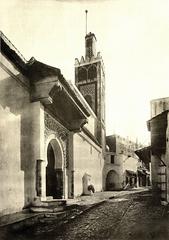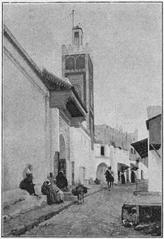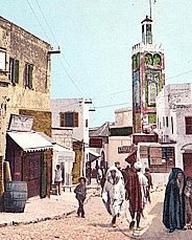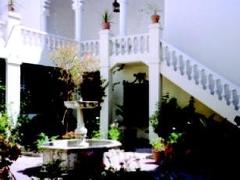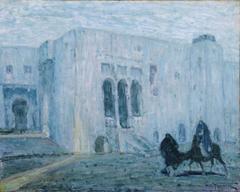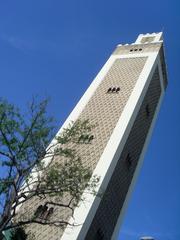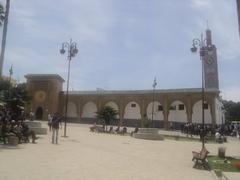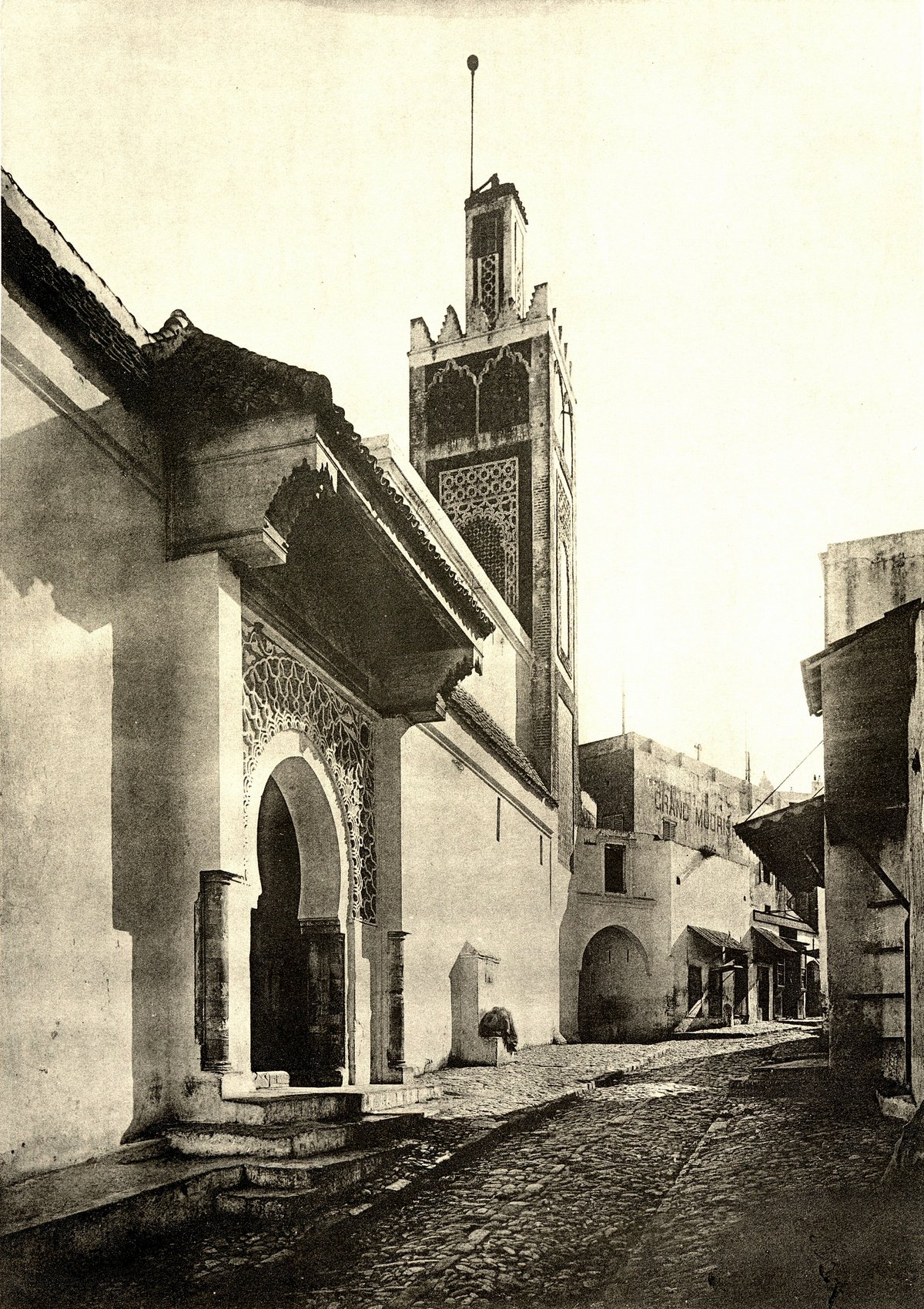
Great Mosque of Tangier: Comprehensive Visitor Guide (Visiting Hours, Tickets, and Historical Insights)
Date: 15/06/2025
Introduction
The Great Mosque of Tangier stands as an enduring symbol of Morocco’s layered religious, cultural, and architectural history. Located in the heart of Tangier’s old medina, the mosque has witnessed centuries of transformation—serving as a Roman temple, a Christian church, and eventually an Islamic place of worship. Its architectural grandeur, historical significance, and central place in urban life make it a must-see attraction for anyone visiting Tangier. This guide provides a detailed overview of the mosque’s origins, architectural features, religious and social importance, practical visiting information, and recommended nearby attractions, ensuring an informed and respectful experience for all visitors (Archnet; Nabataea.net; Away With The Steiners; Barceló Guide).
Table of Contents
- Historical Overview
- Architectural Features
- Cultural and Religious Significance
- Visiting the Great Mosque of Tangier
- Frequently Asked Questions (FAQ)
- Key Historical Timeline
- Conclusion and Practical Tips
- References and Official Links
Historical Overview
Origins and Early Transformations
The site of the Great Mosque of Tangier is a palimpsest reflecting the city’s status as a crossroads of civilizations. Archaeological and historical records indicate that the original structure may have been a Roman temple dedicated to Hercules in the 5th century CE. With the advent of Christianity, the temple was replaced by a church, which stood until the early 8th century, when Arab-Muslim forces conquered Tangier and converted the site into a mosque (Wikipedia; Live the World).
Medieval and Colonial Changes
During the Marinid dynasty (13th–15th centuries), the site was further developed and served as Tangier’s principal Friday mosque (jāmi‘), signifying its central religious and civic role (Barceló Guide). The 15th century saw Tangier fall under Portuguese rule, and the mosque was transformed into a cathedral. In 1662, the English took control, maintaining the site’s Christian character until 1684, when Sultan Moulay Ismail’s forces reclaimed Tangier and restored the mosque’s Islamic function (Wikipedia).
Restoration and Modern Era
The mosque’s present architectural form dates from a comprehensive reconstruction ordered by Sultan Moulay Slimane in the early 19th century (1815–1818). Further renovations and expansions occurred in the 20th and 21st centuries under Sultan Hassan II and King Mohammed VI, preserving the mosque as a living monument to Tangier’s layered religious history (Barceló Guide).
Architectural Features
The Great Mosque of Tangier exemplifies Moroccan and Andalusian design, with its harmonious whitewashed walls, green-tiled roof, and a prominent minaret adorned with geometric patterns and Arabic calligraphy (Barceló Guide; Live the World). The mosque’s façade, completed in the early 19th century, incorporates traditional materials such as brick, stucco, and carved wood. The minaret, square in plan and richly decorated with zellij tilework, dominates the medina skyline, acting as a city landmark.
Inside (for Muslim worshippers only), the mosque features a spacious prayer hall with richly patterned carpets, a beautifully ornamented mihrab, and a finely carved wooden minbar. The interior is illuminated by natural light filtering through small windows, creating a tranquil and contemplative ambiance. The mosque’s layout includes a sahn (open courtyard), often with a central fountain, reflecting typical North African mosque design. Decorative elements such as elaborate stucco, zellij mosaics, and calligraphic inscriptions showcase the artistry of Moroccan craftsmen (Nabataea.net).
Cultural and Religious Significance
Beyond its architectural beauty, the Great Mosque of Tangier is a symbol of Islamic resilience and Moroccan identity. Its repeated transformation through the centuries—from Roman temple, to church, to mosque, and back—mirrors Tangier’s status as a meeting point of Africa and Europe (Live the World; Barceló Guide). As Tangier’s historic Friday mosque, it has been a central hub for prayer, learning, and community affairs.
The mosque also played a role in Morocco’s push for independence; on April 11, 1947, Sultan Mohammed V visited the mosque before delivering a landmark speech that bolstered the national movement (Wikipedia). Today, the mosque remains a focus for religious festivals, charitable activities, and community gatherings.
Visiting the Great Mosque of Tangier
Visiting Hours
- For Muslim worshippers: Open daily for the five obligatory prayers.
- For non-Muslim visitors: The mosque’s interior is not accessible to non-Muslims, in accordance with Moroccan tradition and law. However, the mosque’s exterior and courtyard (where permitted) can be admired at any time, especially during daylight hours (typically 9:00 AM to 6:00 PM).
- During Ramadan and religious holidays: Hours and accessibility may vary; the surrounding medina may be especially busy (Travel Notes and Beyond).
Entry, Tickets, and Etiquette
- Entry: No ticket is required to view the mosque’s exterior; entry to the prayer hall is strictly for Muslims.
- Guided Tours: While interior tours are not available for non-Muslims, licensed guides offer medina walking tours that include the mosque’s exterior and historic context.
- Donations: There is no entrance fee, but donations to local charities or mosque maintenance are welcome.
- Photography: Exterior photography is allowed, but always ask permission before photographing people or religious activities. Avoid taking photos during prayer times.
Accessibility
- The mosque is located in the old medina, surrounded by narrow, cobblestone streets. Accessibility for wheelchairs and those with limited mobility is challenging. Wear comfortable shoes and be prepared for uneven surfaces.
Dress Code and Visitor Conduct
- Dress modestly: Women should cover shoulders, arms, and knees; men should avoid shorts and sleeveless shirts. A headscarf for women is optional but respectful.
- Behavior: Maintain a quiet demeanor around the mosque, avoid eating or drinking in public during Ramadan, and do not block entrances or disturb worshippers.
- Shoes: If you are granted access to courtyard areas, be prepared to remove your shoes.
Getting There and Navigating the Medina
- The mosque is located near Grand Socco and Petit Socco squares, central gathering points in the medina. It is easily accessible on foot from most medina entrances or by taxi from newer parts of the city.
- The area is pedestrian-only, with limited vehicle access.
Recommended Nearby Attractions
- Kasbah Museum: Housed in the former Sultan’s palace, showcasing Tangier’s archaeological and ethnographic history.
- American Legation Museum: The first American public property outside the United States, dedicated to diplomatic history.
- Petit Socco and Grand Socco: Bustling squares with cafes and shops.
- Caves of Hercules: A short drive from the city center, offering natural and mythological intrigue.
Frequently Asked Questions (FAQ)
Q1: Can non-Muslims enter the Great Mosque of Tangier?
A1: No, entry to the prayer hall is reserved for Muslims. Non-Muslims can view and photograph the exterior and courtyard (where accessible) (Archnet).
Q2: What are the mosque’s visiting hours?
A2: The mosque is open for prayers throughout the day. Non-Muslim visitors can admire the exterior from around 9:00 AM to 6:00 PM.
Q3: Is there a fee to visit the mosque?
A3: No, there is no charge to view the mosque from outside.
Q4: Are guided tours available?
A4: Licensed guides offer medina and exterior mosque tours; interior mosque tours are not permitted for non-Muslims.
Q5: Is the mosque accessible for those with mobility challenges?
A5: The medina’s narrow, uneven streets make access difficult for wheelchairs and those with limited mobility.
Key Historical Timeline
- 5th century CE: Site hosts a Roman temple.
- Late antiquity: Temple replaced by a Christian church.
- 8th century: Site converted into a mosque after Muslim conquest.
- 13th–15th centuries: Major expansions under the Marinid dynasty.
- 1471–1684: Converted to a cathedral under Portuguese and later English rule.
- 1684: Sultan Moulay Ismail restores the mosque after Tangier’s return to Moroccan rule.
- 1815–1818: Major reconstruction under Sultan Moulay Slimane.
- 1962 and 2001: Further renovations and restoration works (Archnet; Wikipedia).
Conclusion and Practical Tips
The Great Mosque of Tangier is a living monument that encapsulates the city’s role as a cultural crossroads. While non-Muslim visitors cannot enter the prayer hall, the mosque’s stunning exterior, rich history, and vibrant medina setting make it a highlight of any visit to Tangier. To make the most of your experience:
- Respect local customs and dress codes.
- Visit early in the morning or late afternoon for the best light and fewer crowds.
- Explore nearby attractions for a fuller understanding of Tangier’s heritage.
- For guided tours and up-to-date information, download the Audiala app and follow local travel advisories.
For more on Moroccan architecture and culture, see our related articles and guides.
References and Official Links
- Archnet: Great Mosque of Tangier
- Nabataea.net: Grand Mosque of Tangier
- Away With The Steiners: Best Things to Do in Tangier
- Barceló Guide: Grand Mosque of Tangier
- Wikipedia: Grand Mosque of Tangier
- Live the World: Grand Mosque of Tangier
- Travel Notes and Beyond: Visiting Morocco Travel Guide
- Trip101: Best Things to Do in Tangier
- Ibn Battuta Travel: Famous Moroccan Mosques
- Regency Holidays: Places to Visit in Tangier
Explore Tangier’s living history with respect and curiosity. For the most up-to-date travel resources, guided tours, and cultural insights, download the Audiala app and follow our latest articles.
